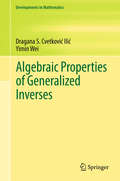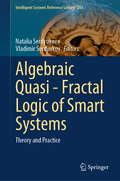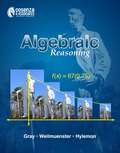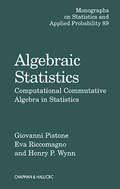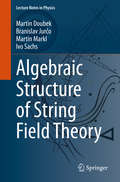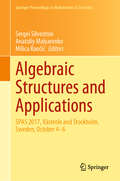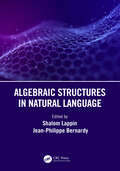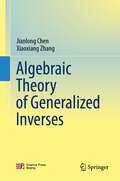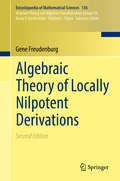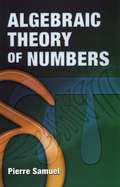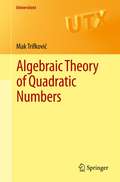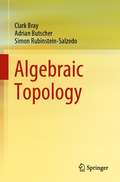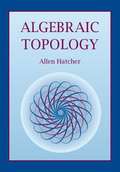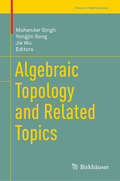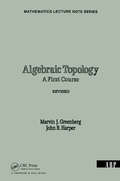- Table View
- List View
Algebraic Properties of Generalized Inverses (Developments in Mathematics #52)
by Dragana S. Cvetković Ilić Yimin WeiThis book addresses selected topics in the theory of generalized inverses. Following a discussion of the "reverse order law" problem and certain problems involving completions of operator matrices, it subsequently presents a specific approach to solving the problem of the reverse order law for {{1}} -generalized inverses. Particular emphasis is placed on the existence of Drazin invertible completions of an upper triangular operator matrix; on the invertibility and different types of generalized invertibility of a linear combination of operators on Hilbert spaces and Banach algebra elements; on the problem of finding representations of the Drazin inverse of a 2x2 block matrix; and on selected additive results and algebraic properties for the Drazin inverse. In addition to the clarity of its content, the book discusses the relevant open problems for each topic discussed. Comments on the latest references on generalized inverses are also included. Accordingly, the book will be useful for graduate students, PhD students and researchers, but also for a broader readership interested in these topics.
Algebraic Quasi—Fractal Logic of Smart Systems: Theory and Practice (Intelligent Systems Reference Library #251)
by Natalia Serdyukova Vladimir SerdyukovThis book is a continuation of the Algebraic Formalization of Smart Systems. Theory and Practice, 2018, and Algebraic Identification of Smart Systems. Theory and Practice, 2021. Algebraic logic refers to the connection between Boolean algebra and classical propositional calculus. This connection was discovered by George Boole and then developed by other mathematicians, such as C. S. Peirce and Ernst Schroeder. This trend culminated in the Lindenbaum-Tarski algebras. Here we try to connect algebraic logic and quasi-fractal technique, based on algebraic formalization of smart systems to get facts about smart systems functioning and connections of their qualitative and quantitative indicators. Basic techniques we used: algebraic quasi-fractal systems, Erdős–Rényi algorithm, a notion of –giant component of an algebraic system, fixed point theorem, purities, i.e., embeddings preserving -property of an algebraic system. The book is aimed for all interested in these issues.
Algebraic Reasoning
by Paul Gray Jacqueline Weilmuenster Jennifer HylemonConsumable student worktext containing the Engage, Explore, and Explain sections of the Algebraic Reasoning textbook.
Algebraic Reasoning
by Paul Gray Jacqueline Weilmuenster Jennifer HylemonAlgebraic Reasoning by Paul Gray, Jacqueline Weilmuenster, Jennifer Hylemon
Algebraic Statistics: Computational Commutative Algebra in Statistics (Chapman & Hall/CRC Monographs on Statistics and Applied Probability)
by Henry P. Wynn Giovanni Pistone Eva RiccomagnoWritten by pioneers in this exciting new field, Algebraic Statistics introduces the application of polynomial algebra to experimental design, discrete probability, and statistics. It begins with an introduction to Grobner bases and a thorough description of their applications to experimental design. A special chapter covers the binary case
Algebraic Structure of String Field Theory (Lecture Notes in Physics #973)
by Martin Doubek Branislav Jurčo Martin Markl Ivo SachsThis book gives a modern presentation of modular operands and their role in string field theory. The authors aim to outline the arguments from the perspective of homotopy algebras and their operadic origin. Part I reviews string field theory from the point of view of homotopy algebras, including A-infinity algebras, loop homotopy (quantum L-infinity) and IBL-infinity algebras governing its structure. Within this framework, the covariant construction of a string field theory naturally emerges as composition of two morphisms of particular odd modular operads. This part is intended primarily for researchers and graduate students who are interested in applications of higher algebraic structures to strings and quantum field theory. Part II contains a comprehensive treatment of the mathematical background on operads and homotopy algebras in a broader context, which should appeal also to mathematicians who are not familiar with string theory.
Algebraic Structures and Applications: SPAS 2017, Västerås and Stockholm, Sweden, October 4-6 (Springer Proceedings in Mathematics & Statistics #317)
by Anatoliy Malyarenko Sergei Silvestrov Milica RančićThis book explores the latest advances in algebraic structures and applications, and focuses on mathematical concepts, methods, structures, problems, algorithms and computational methods important in the natural sciences, engineering and modern technologies. In particular, it features mathematical methods and models of non-commutative and non-associative algebras, hom-algebra structures, generalizations of differential calculus, quantum deformations of algebras, Lie algebras and their generalizations, semi-groups and groups, constructive algebra, matrix analysis and its interplay with topology, knot theory, dynamical systems, functional analysis, stochastic processes, perturbation analysis of Markov chains, and applications in network analysis, financial mathematics and engineering mathematics. The book addresses both theory and applications, which are illustrated with a wealth of ideas, proofs and examples to help readers understand the material and develop new mathematical methods and concepts of their own. The high-quality chapters share a wealth of new methods and results, review cutting-edge research and discuss open problems and directions for future research. Taken together, they offer a source of inspiration for a broad range of researchers and research students whose work involves algebraic structures and their applications, probability theory and mathematical statistics, applied mathematics, engineering mathematics and related areas.
Algebraic Structures in Natural Language
by Jean-Philippe BernardyAlgebraic Structures in Natural Language addresses a central problem in cognitive science concerning the learning procedures through which humans acquire and represent natural language. Until recently algebraic systems have dominated the study of natural language in formal and computational linguistics, AI, and the psychology of language, with linguistic knowledge seen as encoded in formal grammars, model theories, proof theories and other rule-driven devices. Recent work on deep learning has produced an increasingly powerful set of general learning mechanisms which do not apply rule-based algebraic models of representation. The success of deep learning in NLP has led some researchers to question the role of algebraic models in the study of human language acquisition and linguistic representation. Psychologists and cognitive scientists have also been exploring explanations of language evolution and language acquisition that rely on probabilistic methods, social interaction and information theory, rather than on formal models of grammar induction. This book addresses the learning procedures through which humans acquire natural language, and the way in which they represent its properties. It brings together leading researchers from computational linguistics, psychology, behavioral science and mathematical linguistics to consider the significance of non-algebraic methods for the study of natural language. The text represents a wide spectrum of views, from the claim that algebraic systems are largely irrelevant to the contrary position that non-algebraic learning methods are engineering devices for efficiently identifying the patterns that underlying grammars and semantic models generate for natural language input. There are interesting and important perspectives that fall at intermediate points between these opposing approaches, and they may combine elements of both. It will appeal to researchers and advanced students in each of these fields, as well as to anyone who wants to learn more about the relationship between computational models and natural language.
Algebraic Techniques and Their Use in Describing and Processing Uncertainty: To the Memory of Professor Elbert A. Walker (Studies in Computational Intelligence #878)
by Vladik Kreinovich Hung T. NguyenThis book discusses heuristic methods – methods lacking a solid theoretical justification – which are ubiquitous in numerous application areas, and explains techniques that can make heuristic methods more reliable. Focusing on algebraic techniques, i.e., those that use only a few specific features of a situation, it describes various state-of-the-art applications, ranging from fuzzy methods for dealing with imprecision to general optimization methods and quantum-based methods for analyzing economic phenomena. The book also includes recent results from leading researchers, which could (and hopefully will) provide the basis for future applications. As such, it is a valuable resource for mathematicians interested in potential applications of their algebraic results and ideas, as well as for application specialists wanting to discover how algebraic techniques can help in their domains.
Algebraic Theories (Dover Books on Mathematics)
by Leonard DicksonThis in-depth introduction to classical topics in higher algebra provides rigorous, detailed proofs for its explorations of some of mathematics' most significant concepts, including matrices, invariants, and groups. Algebraic Theories studies all of the important theories; its extensive offerings range from the foundations of higher algebra and the Galois theory of algebraic equations to finite linear groups (including Klein's "icosahedron" and the theory of equations of the fifth degree) and algebraic invariants. The full treatment includes matrices, linear transformations, elementary divisors and invariant factors, and quadratic, bilinear, and Hermitian forms, both singly and in pairs. The results are classical, with due attention to issues of rationality. Elementary divisors and invariant factors receive simple, natural introductions in connection with the classical form and a rational, canonical form of linear transformations. All topics are developed with a remarkable lucidity and discussed in close connection with their most frequent mathematical applications.
Algebraic Theory of Generalized Inverses
by Jianlong Chen Xiaoxiang ZhangMost of the existing monographs on generalized inverses are based on linear algebra tools and geometric methods of Banach (Hilbert) spaces to introduce generalized inverses of complex matrices and operators and their related applications, or focus on generalized inverses of matrices over special rings like division rings and integral domains, and does not include the results in general algebraic structures such as arbitrary rings, semigroups and categories, which are precisely the most general cases.In this book, five important generalized inverses are introduced in these algebraic structures. Moreover, noting that the (pseudo) core inverse was introduced in the last decade and has attracted much attention, this book also covers the very rich research results on it, so as to be a necessary supplement to the existing monographs. This book starts with decompositions of matrices, introduces the basic properties of generalized inverses of matrices, and then discusses generalizedinverses of elements in rings and semigroups, as well as morphisms in categories. The algebraic nature of generalized inverses is presented, and the behavior of generalized inverses are related to the properties of the algebraic system.Scholars and graduate students working on the theory of rings, semigroups and generalized inverses of matrices and operators will find this book helpful.
Algebraic Theory of Locally Nilpotent Derivations (Encyclopaedia of Mathematical Sciences #136.3)
by Gene FreudenburgThis book explores the theory and application of locally nilpotent derivations, a subject motivated by questions in affine algebraic geometry and having fundamental connections to areas such as commutative algebra, representation theory, Lie algebras and differential equations. The author provides a unified treatment of the subject, beginning with 16 First Principles on which the theory is based. These are used to establish classical results, such as Rentschler's Theorem for the plane and the Cancellation Theorem for Curves. More recent results, such as Makar-Limanov's theorem for locally nilpotent derivations of polynomial rings, are also discussed. Topics of special interest include progress in classifying additive actions on three-dimensional affine space, finiteness questions (Hilbert's 14th Problem), algorithms, the Makar-Limanov invariant, and connections to the Cancellation Problem and the Embedding Problem. A lot of new material is included in this expanded second edition, such as canonical factorization of quotient morphisms, and a more extended treatment of linear actions. The reader will also find a wealth of examples and open problems and an updated resource for future investigations.
Algebraic Theory of Numbers
by Pierre Samuel Allan J. SilbergerAlgebraic number theory introduces students not only to new algebraic notions but also to related concepts: groups, rings, fields, ideals, quotient rings and quotient fields, homomorphisms and isomorphisms, modules, and vector spaces. Author Pierre Samuel notes that students benefit from their studies of algebraic number theory by encountering many concepts fundamental to other branches of mathematics — algebraic geometry, in particular.This book assumes a knowledge of basic algebra but supplements its teachings with brief, clear explanations of integrality, algebraic extensions of fields, Galois theory, Noetherian rings and modules, and rings of fractions. It covers the basics, starting with the divisibility theory in principal ideal domains and ending with the unit theorem, finiteness of the class number, and the more elementary theorems of Hilbert ramification theory. Numerous examples, applications, and exercises appear throughout the text.
Algebraic Theory of Quadratic Numbers (Universitext)
by Mak TrifkovićBy focusing on quadratic numbers, this advanced undergraduate or master's level textbook on algebraic number theory is accessible even to students who have yet to learn Galois theory. The techniques of elementary arithmetic, ring theory and linear algebra are shown working together to prove important theorems, such as the unique factorization of ideals and the finiteness of the ideal class group The book concludes with two topics particular to quadratic fields: continued fractions and quadratic forms The treatment of quadratic forms is somewhat more advanced than usual, with an emphasis on their connection with ideal classes and a discussion of Bhargava cubes. The numerous exercises in the text offer the reader hands-on computational experience with elements and ideals in quadratic number fields The reader is also asked to fill in the details of proofs and develop extra topics, like the theory of orders Prerequisites include elementary number theory and a basic familiarity with ring theory.
Algebraic Thinking Foundations (3rd Edition)
by Brian E. Enright Linda L. Mannhardt Leslie G. BakerAlgebraic thinking is much more than a formal course called Algebra and here it refers to mathematics of the type used every day both in the home and the workplace--from rates of auto fuel consumption to planning budgets.
Algebraic Thinking Foundations Assessment Skill Builder (Maryland Student's Edition)
by National Training NetworkThis edition contains Daily Assessments: Lessons, Extension- Identify Increase, Decrease, or No Change in a Linear Graph; Expanded Form and Drawing Geometric Figures.
Algebraic Thinking, Part One (3rd Edition)
by Brian E. Enright Linda L. Mannhardt Leslie G. BakerThis mathematics book is aimed at helping students improve and understand algebraic reasoning.
Algebraic Thinking, Part One: Assessment Skill Builder (Maryland Student Edition)
by National Training NetworkAlgebra textbook, with chapters: Express Decimals in Expanded Form; Simplify Expressions Using Laws of Exponents; Construction Lesson; Percent of Change; Finding the Missing Angle; Rate of Change of a Linear Relationship; Slope; Create Scatter Plots on the Graphing Calculator.
Algebraic Thinking, Part Two (4th Edition)
by Brian E. Enright Linda L. Mannhardt Leslie G. Baker Lisa O. Schueren Colleen E. WeldAlgebraic Thinking Part 2 equips students to find algebraic answers by thinking and using manipulatives.
Algebraic Thinking, Part Two: Assessment Skill Builder (Maryland Student Edition)
by National Training NetworkThis second part of Maryland student's edition contains 135 lessons on algebra besides lessons on extensions: Arithmetic and Geometric Sequences; Scale Drawings - Real World Problems; Multiple Transformations; and Constructions.
Algebraic Topology
by Simon Rubinstein-Salzedo Clark Bray Adrian ButscherAlgebraic Topology is an introductory textbook based on a class for advanced high-school students at the Stanford University Mathematics Camp (SUMaC) that the authors have taught for many years. Each chapter, or lecture, corresponds to one day of class at SUMaC. The book begins with the preliminaries needed for the formal definition of a surface. Other topics covered in the book include the classification of surfaces, group theory, the fundamental group, and homology. This book assumes no background in abstract algebra or real analysis, and the material from those subjects is presented as needed in the text. This makes the book readable to undergraduates or high-school students who do not have the background typically assumed in an algebraic topology book or class. The book contains many examples and exercises, allowing it to be used for both self-study and for an introductory undergraduate topology course.
Algebraic Topology
by Allen HatcherIn most major universities one of the three or four basic first-year graduate mathematics courses is algebraic topology. This introductory text is suitable for use in a course on the subject or for self-study, featuring broad coverage and a readable exposition, with many examples and exercises. The four main chapters present the basics: fundamental group and covering spaces, homology and cohomology, higher homotopy groups, and homotopy theory generally. The author emphasizes the geometric aspects of the subject, which helps students gain intuition. A unique feature is the inclusion of many optional topics not usually part of a first course due to time constraints: Bockstein and transfer homomorphisms, direct and inverse limits, H-spaces and Hopf algebras, the Brown representability theorem, the James reduced product, the Dold-Thom theorem, and Steenrod squares and powers.
Algebraic Topology and Related Topics (Trends in Mathematics)
by Jie Wu Mahender Singh Yongjin SongThis book highlights the latest advances in algebraic topology, from homotopy theory, braid groups, configuration spaces and toric topology, to transformation groups and the adjoining area of knot theory. It consists of well-written original research papers and survey articles by subject experts, most of which were presented at the “7th East Asian Conference on Algebraic Topology” held at the Indian Institute of Science Education and Research (IISER), Mohali, Punjab, India, from December 1 to 6, 2017. Algebraic topology is a broad area of mathematics that has seen enormous developments over the past decade, and as such this book is a valuable resource for graduate students and researchers working in the field.
Algebraic Topology: A First Course (Contemporary Mathematics Ser. #Vol. 58)
by Marvin J. GreenbergGreat first book on algebraic topology. Introduces (co)homology through singular theory.
Algebraic Topology: VIASM 2012–2015 (Lecture Notes in Mathematics #2194)
by H. V. Hưng Nguyễn Lionel SchwartzHeld during algebraic topology special sessions at the Vietnam Institute for Advanced Studies in Mathematics (VIASM, Hanoi), this set of notes consists of expanded versions of three courses given by G. Ginot, H. -W. Henn and G. Powell. They are all introductory texts and can be used by PhD students and experts in the field. Among the three contributions, two concern stable homotopy of spheres: Henn focusses on the chromatic point of view, the Morava K(n)-localization and the cohomology of the Morava stabilizer groups. Powell's chapter is concerned with the derived functors of the destabilization and iterated loop functors and provides a small complex to compute them. Indications are given for the odd prime case. Providing an introduction to some aspects of string and brane topology, Ginot's contribution focusses on Hochschild homology and its generalizations. It contains a number of new results and fills a gap in the literature.
